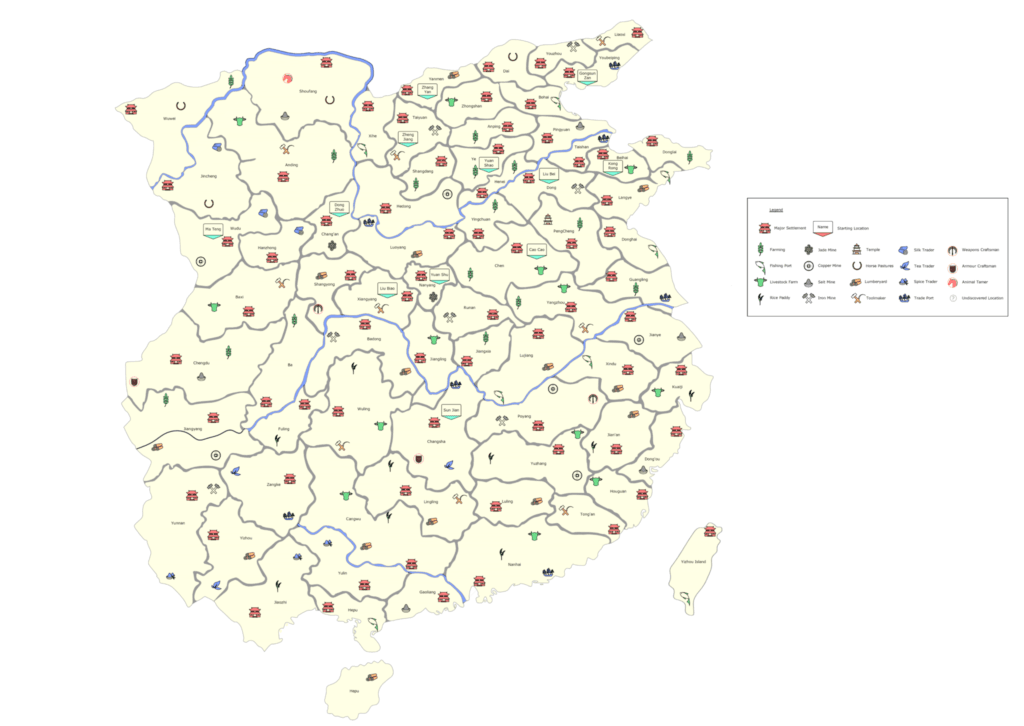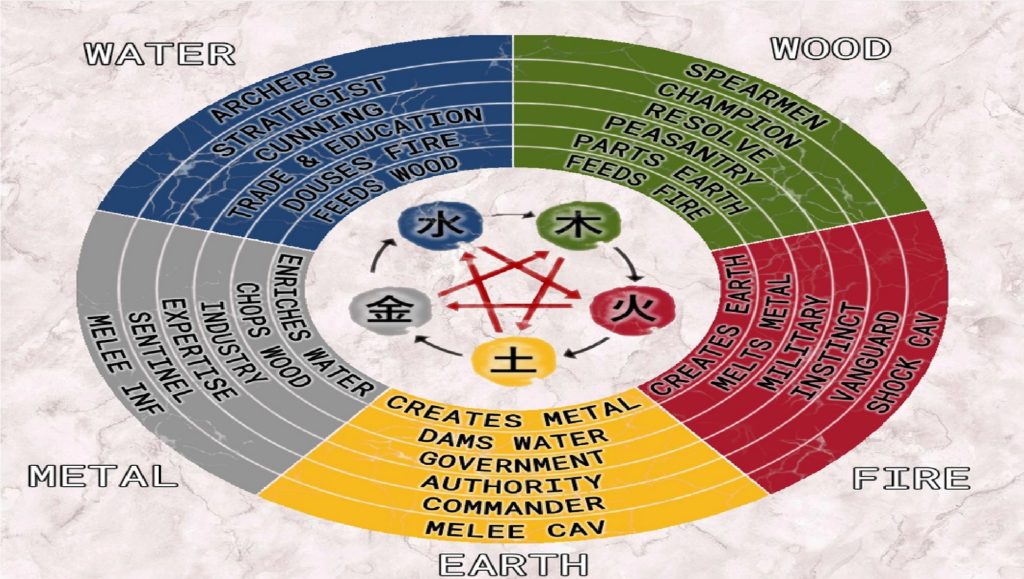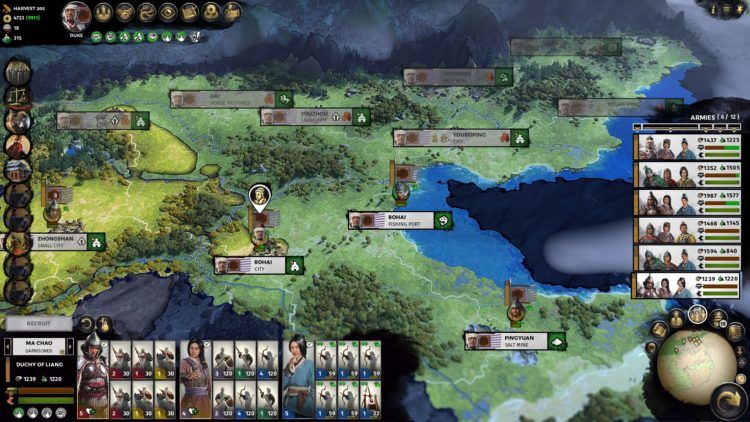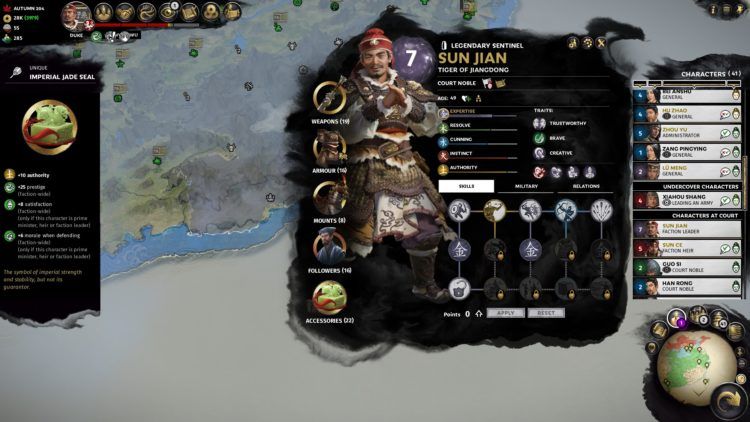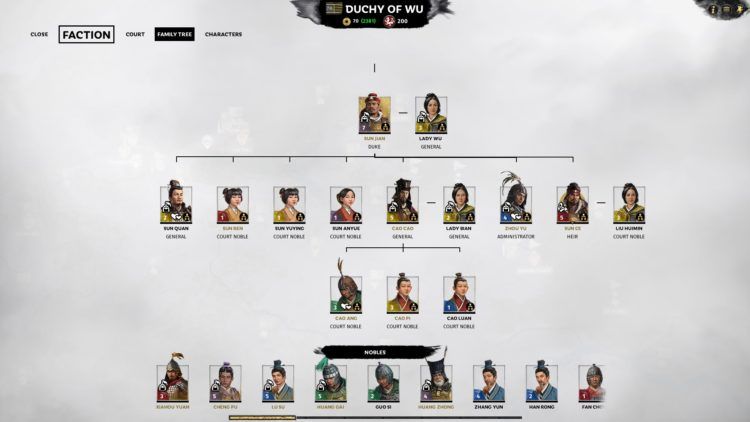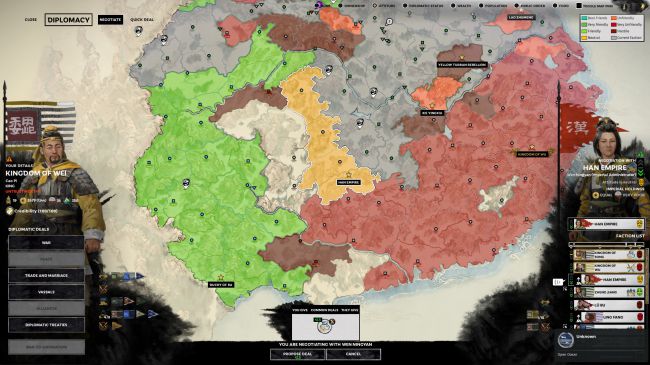Beginner’s Guide
Total War: Three Kingdoms is a game set back in history. There is a battle going on in China and are supposed to take part in it along with maintaining your hold on the 75 provinces under you. The game requires you to have some sense of diplomacy and making smart moves in maintaining the administrations while also always keeping an eye on your enemy units. Let us learn about the different aspects of the game together with our Total War: Three Kingdoms Beginners Guide.
The Campaign Map
It’s all one big battle royale in China, and neither Fortnite nor PUBG are involved. There are over 75 commanderies (provinces) for you to control, each with their own cities and settlements. Terrain and geographical location play a major role in the landscape and background of the battles you fight as well. A battle for a trade port in the Yangtze River will look different compared to a battle in a port facing the open sea.
If you need to know what the entire map looks like, including the settlements and resources therein, just refer to the image below from Reddit user Skeewbs1. He’s been working on this project prior to the game’s release, taking down notes from various streamers and reviewers.
Faction Leaders
There are currently five different types of faction leaders in Total War: Three Kingdoms.
Coalition members such as Cao Cao and Liu Bei expand their territory to earn prestige. Capturing the city where the Han Emperor resides allows you to vassalize the Han Empire. Once any faction leader becomes king, they declare themselves emperors, along with the two other leaders that are the strongest. To win the campaign, you’ll need to take out the seats of your two rival emperors.
Governors such as Ma Teng and Liu Biao are loyal to the Han. The same progression for Coalition members still applies for their campaign, including capturing the Han Emperor. The difference is that even if governors do become kings, they do not declare themselves as emperors automatically. Their goal, therefore, is to take out all three pretenders to the throne. If you manage to capture a pretender’s capital, that’s when you’ll declare yourself as their equal.
Outlaws such as Zheng Jiang and Zhang Yan have the same progression as Warlords. The difference is that they cannot vassalize the Han. Another key feature is that, at least with Zhang Yan, he can have diplomatic relations with the generic Yellow Turbans faction as well.
The Tyrant faction leader only has one example: Dong Zhuo. The power-hungry demagogue starts at war with almost every other faction. The good news is that you have the mighty Lu Bu at your side, and your faction rank is higher, allowing for more armies, administrators, and spies compared to your rivals. You already have the Han Emperor under your control and the Han Empire itself as a vassal.
The last type of faction leaders is the Yellow Turbans. He Yi, Gong Du, and Huang Shao are rebels who are counted as a different subculture compared to the Han officers, and thus they can field different units. They also have a slightly different playstyle. They’ll be made playable as an early adopter bonus once the game launches on May 23.
Wu Xing
The Chinese philosophy of Wu Xing, which is about the world’s elements all coalescing and contributing as part of a cycle, is very much present in Total War: Three Kingdoms. The elements are earth (yellow), fire (red), wood (green), metal (grey), water (blue).
You’ll notice this color-coding system for your officers, showing how they represent a particular archetype and their stat allocation. You’ll also see this in unit types, where the color-coding or elements can complement or counteract another — ie. melee cavalry (earth/yellow) complement sword infantry (metal/grey) due to the inherent resistance to missiles from archers (water/blue). You might even see this philosophy in the five building types for settlements.
Characters
Total War: Three Kingdoms has hundreds of characters in the game. Many of these, however, are your generic, non-historical additions. However, there’s still quite a number of actual historical officers who lived and ruled at the time. Characters that die in Total War: Three Kingdoms are gone for good.
Characters with a golden nameplate are considered legendary. They have slightly better stats, and they may even offer more perks when assigned to positions. The most important factor though would be resiliency. Legendary characters can suffer more “wounds” before they’re outright killed.
Characters also have a “satisfaction” mechanic. Basically, it’s their loyalty to you. Satisfaction may increase or decrease because of random events, length of time spent together in the same location or army, the need for higher positions in your government, or character traits. For instance, if there’s a big red “X” mark for two people in the same city or army, it means they’re not getting along well. This can lead to dissatisfaction for both.
Character Classes or Archetypes
As mentioned, the philosophy of Wu Xing plays a major role, as the elements and color-coding are present:
- Commanders (earth/yellow) provide decent bonuses to melee cavalry, faction opinion, and peasant income via the focus on the Authority stat (character satisfaction and unit morale).
- Vanguards (fire/red) focus on shock cavalry, for the most part, speed, and blitzing through enemy lines. They also focus more on the Instinct stat (melee damage and recruitment cost discounts).
- Champions (wood/green) are your duelists who can be very tough to beat in straight up fights, with boosts to spearmen and food production. They focus on the Resolve stat (health increase and population growth).
- Sentinels (metal/grey) are front-liners who can take loads of damage while playing defensively. They focus on swordsmen and shielded infantry, industry boosts, and the Expertise stat (construction cost discounts and melee evasion).
- Strategists (water/blue) are tactical geniuses who handle commerce/trade assignments, with a knack for boosting archer units and siege weapons. Strategists should have a high Cunning stat (ammunition increase and military supplies).
Each character class in Romance Mode will have unique skills. For instance, Commanders can use a buff that blocks arrows, Vanguards have an AoE smite attack, and Strategists can improve (or debuff) ability cooldowns.
Retinues
Unlike previous Total War games, Total War: Three Kingdoms makes recruitment more personal via retinues. Each army can be comprised of three officers, and each officer can have up to six units as part of their personal retinue. These retinues cannot be handed off separately as units, you’ll need to transfer the actual officer along with their entire retinue. These units, though, can be swapped out for other types or disbanded. Retinues will be part of the officer’s card even if they ended up in another faction.
Ideally, to make the most out of an officer’s retinue, you’ll want to look at their respective class and possible talents. For instance, Strategists with high Cunning skill will have more ammunition and they also gain access to siege weapons. They even have talents to use fire arrows or flaming trebuchet shots. Putting a lot of missile units for a Vanguard or Champion type would be detrimental since they focus on shock cavalry and spear infantry respectively.
Ancillaries
In Total War: Three Kingdoms, the character bio panel is a lot cleaner and more intuitive than previous Total War games. You’ll clearly see your character’s rank/job title, their talents, and even the items they have equipped. You can choose to have weapons, armor, mounts, followers, and accessories.
The last two might require a tidbit of information. There are certain followers and accessories that increase officer satisfaction and stat lines, provide new unit formations or additional administrative options. More important though are followers that provide faction-wide perks such as industry income, officer satisfaction, corruption reduction, extra experience points, or public order. These are only available to the faction leader, faction heir, and prime minister.
Officer Recruitment
There are multiple ways to obtain new officers:
- defeating an army in battle has a chance to let you capture an officer; some officers can be employed
- confederating or “diplo-annexing” (vassalize then annex) a faction will also lead to all officers joining you
- forcing a leader to abdicate to your rule (if you’re both leading kingdoms) will lead to the control of that entire faction as well
- a spy embedded in a faction may cause a civil war, and those loyal to your spy will join your faction
- the spy can also lower the satisfaction of officers in a rival faction, and they may leave that leader’s service
- arranged marriages
- roaming characters may also end up in your recruitment pool
- defeated factions may have their characters scattered across all of China, and you may even encounter legendary heroes or former faction leaders
- a handful of events may lead to historical heroes being recruited
Your Family, Court, and Assignments
Your faction’s court shows all the available government positions, along with the recruitment pool of “free agent” characters. The faction leader, faction heir, and prime minister have bonus perks by way of ancillaries as mentioned above.
Administrators, meanwhile, can handle cities, providing a wealth of bonuses depending on the officer. Council positions will provide you with missions that add bonuses when you complete them (such as increased commerce income). Unlike administrator positions, council member perks are universal and not tied to a specific officer’s talents. Those assigned to any positions in the court can still go to battle or complete an assignment.
Assignments are short-term tasks for your officers. Based on their class and talents, you can place them in cities to boost income for peasantry, industry, or commerce. They can also provide construction discounts, public order increase, or satisfaction boosts.
Building your dynasty is also necessary for Total War: Three Kingdoms. It’s even possible, through the machinations of the AI, a competing player, or your own faults, for your faction to devolve into civil war due to mismanagement. You can adopt characters, or even marry them off to your officers, continuing your dynastic line.
Useful Tips
Don’t feed the rebels
Rebels are always a pain in Total War, forcing you to acknowledge your failures as a leader and waste time fighting your own people. They spring up in discontent provinces as a growing rabble that’ll usually besiege the nearest settlement, making you divert troops to deal with them. This happens in Three Kingdoms, too, but this time there’s also a complication in the form of the Yellow Turban Rebellion. It works like the other factions, competing over the empire with heroes and armies and diplomacy, but it also feeds on the rebellions popping off across the map.
In other Total War games, you can just march over to rebel-occupied settlements and kick them out, as long as you can win the battle. In Three Kingdoms, that settlement immediately joins the Yellow Turban Rebellion. Aside from their name, the random rebellions are treated as entirely separate from the faction, so you can be at peace with the Yellow Turban Rebellion and still fight rebels, but that changes moments the siege ends in their favour. If you want it back, you’ll need to declare war on the faction or make a trade. It’s a whole lot of hassle that you don’t want to get into.
Keep in touch with your spies
Three Kingdoms has given Total War’s espionage system a much needed upgrade, allowing you to send members of your court into the employ of other factions to do your nefarious bidding. They can create underground networks, hold office and even lead armies, all while secretly working for you. Once they’re hanging around the enemy court, they can be recruited by that faction’s leader and they’ll play the role they’re assigned. And that’s how I lost track of one agent. I sent him abroad, got embroiled in a war and had no clue that he’d been given an army to lead. Not until I killed him and routed that army, anyway. He was very convincing!
Everything is colour-coded
This should become apparent pretty quickly but is still worth highlighting. Character classes, research, buildings and units are all assigned colours that correspond to the elements. Military buildings, martial research and aggressive Vanguard leaders are all red, for instance, and red units are more likely to match their general’s combat style. To play to a Vanguard’s strengths, you’ll probably want to give them a retinue full of shock cavalry to back them up when they smash through the enemy line. Each class has an elite unit only it can recruit, but aside from that they can be mixed and matched.
Everyone goes wild for trinkets
You’ll collect all sorts of personal items and followers, so many that you won’t know what to do with them all. As you recruit more characters, you’ll be able to arm them, give them retainers and put them on a lovely horse, but you’ll inevitably end up with a pile of things you don’t really need. Another might, however, so you can use any of these things to sweeten the deal when you’re at the negotiating table. It’s amazing what a small wooden pig can get you in return. It might be the difference between getting told to piss off and making peace. You’ll probably start to get sick of all the leaders hitting you up for new toys, however, so it’s a double-edged sword.
Be aggressive with your heroes
The heroic characters who join your empire are vital to the conquest of China, but that doesn’t mean you should hide them behind a wall of spears. Characters serve so many functions—they could be a general, a minister and overseeing one of your provinces all at the same time—and have all these relationships that it can be tempting to keep them out of harm’s way, but they are more than capable of handling themselves.
While typical historical Total War generals are just strong cavalry units with the occasional special ability, Three Kingdoms’ heroes are super-charged warriors who can smash into units, lock them down and, pretty swiftly, wipe them out. Some classes are better at fighting other heroes, while others are best used with archers, but all of them can easily hold their own against several units at once. Most of what you’ll be doing in a battle is moving them around, directing them to hotspots and terrifying mere mortals with devastating charges and special attacks. Legendary heroes also get unique abilities and can’t be killed in battle, though they can be executed if they’re captured.
Build a Kingdom
Carefully plan the development of your Kingdom
In Total War Three Kingdoms, Kingdom development progresses is related with unlocking the relevant reforms. These can be selected every 5 turns, each of which offers different bonuses – increased food production, additional revenues to the treasury, or you may even unlock new buildings/units. It is necessary to plan the development already at the beginning and focus on those reforms that will allow you to unlock access to the most useful features for your style of play – by those we mean abilities, units or buildings.
Take care of the treasury state and food supplies
Gold has a key role in Total War Three Kingdoms – thanks to it you can train new units, build more buildings and hire special units with effective skills. Its absence will significantly slow down the development of the Kingdom, and in extreme situations can lead to bankruptcy and the gradual loss of troops. Taking care of adequate food level is also a key factor of success – the high level increases the amount of gold extracted from the peasantry. Lack of gold may slow down the overall development of your commanders.
Keep track of the public order level in your commanderies
Public Order – is one of the main mechanics of city management in the Total War game series. You should always adhere to an adequately high level of public order (preferably in the area of maximum ~ 100) – even a sudden and significant drop of this value won’t cause any threat. You can’t allow public order to fall to the value of -100 (minus one hundred), as this can cause rebellion and loss of control over the city. Public order increases the presence of the army, reduces taxes and lowers cost of some buildings.
Note – it’s worth to have at least one building that increases your public order in a city or settlement inside the commandery.
As far as possible – take control of all the commanderies
Unless one of the settlements or cities owned by commandery is under the leadership of your ally, it is always recommended to capture the entire commandery. This will allow you to prevent fluctuations in the level of public order (the constant capturing of the settlement has a negative impact on this). Also, you will have access to more space for buildings inside it.
Secure settlements located on the borders with a hostile faction
It is best to keep one of your armies in such a place, so that it can intervene if necessary. However, if this is not possible, it is necessary to build structures in nearby settlements that will increase the garrison. With a sufficiently expanded garrison, enemies will not be able to capture the settlement with just one army. It will also increase the time required to lead a siege, giving your troops time to get to the vulnerable location.
Regularly increase food production
With further development and increase of settlements and cities, they food requirements of your Kingdom will also grow accordingly. The amount of food produced can be increased with the help of special buildings and a significant part can be obtained through trade with other factions.
Think twice before starting military action against another faction
Before declaring a war on anyone and launching a campaign, it is necessary to ensure an appropriate level of public order, proper level of state treasury and food production, so that the Kingdom can function effectively. Conquering even half of the map for a dozen tours is useless if the vault is empty, and a low level of public order will lead to uprisings and the loss of subsequent, newly conquered possessions.
Never fight with multiple factions at the same time
Even if your Kingdom is several times stronger than those from nearby neighbors, and you own half the map, you’ll never be able to fight multiple factions at the same time, on different fronts. It is necessary to eliminate the threat step by step – and if the elimination is not possible, use diplomacy to conclude a temporary peace with a neighboring faction, allowing you to solve other problems alone.
Try to fight just on one front
After a few dozen rounds of the campaign, your lands are going to stretch through a large part of the map. In such situation fight only on one front – so the enemy that is distant with a dozen turns of march couldn’t suddenly perform a back-side attack, conquering one of the settlements, and beginning his expansion into your territory.
Don’t expand your army too fast
In the first few turns of the game, one army consisting of 15-16 units is enough to conduct successful military operations. Create another army and fill it with troops only when you will be able to maintain the growth of gold at 1,000 pieces per turn.
Give the units of your army some time to regenerate
If your army has just fought a battle and its troops are scattered, wait a few rounds before launching another offensive. Troops require several tours (depending on the territories and buildings located in the cities) for full regeneration. Wounded units are much worse in the fight than healthy ones.
Consider reducing the army if the treasury of the state does not allow you to maintain so many military units
Having a large army is tempting – it will allow you to easily overcome enemies and conquer new territories. However, if the state of your vault does not allow you to maintain dozens of different units throughout the map, you may want to consider a temporary elimination of units to reduce the demand for gold and give your vault a little “space”. When the situation normalizes, the troops can be re-hired and put back into the army.
Don’t send the General into battle alone
Total War Three Kingdoms allows you to customize the gameplay mode, giving access to Story and Archives. In this former, generals are powerful units that can decimate the enemy army alone. However, sending them alone against an entire enemy army is a bad idea – an outnumbered general can very quickly be killed, which will be a giant blow to your army’s morale. Use generals to support troops on the battlefield instead.
Watch the morale of the troops
The morale of your units is the second most important stat after their health. When the unit’s morale indicator reaches zero, it will run away from the battlefield and you will lose control of it. Moreover, the fleeing troops have a negative impact on the morale of the closest allies, so things can spiral out of control quickly. The portraits of the units whose morale breaks will flash in white – as soon as you notice that, allow them to retreat for a moment, or use the special ability of the generals to boost their spirits.
Do not exhaust units
Each unit – a General, infantry or cavalry – has its own stamina index. Under normal conditions, units enter battle as rested, and tire out by fighting or covering long distances. Exhausted units are way less efficient in battle – the cavalry will not be able to charge, the infantry will be slower and less accurate and so on – there is also a decrease in morale. Watch out for fatigue and give your units some time to recover before engaging.
Attention – prevent fatigue before the battle proper. Do not charge from the other end of the map at the enemy units; before engaging the enemy, give the troops some time to recover after a long march.
Learn the types of units and use that knowledge in battle
In Total War Three Kingdoms there are different types of troops – cavalry, melee units equipped with different types of weapons and shields, ranged units or siege engines – all of them differently armored (light and medium to heavy). Each type of troops is most effective against some units, and less effective against others – cavalry will blow crossbowmen into dust, but will be crushed by a wall of spearmen, who, in turn, are nearly defenseless against heavily armored infantry. Learn the types of units (and read their descriptions!) to know how to use them effectively in combat.
Try to flank the enemy troops and don’t let the enemy do the same
Flanking means attacking the enemy from the sides or from behind. This has an extremely negative impact on the morale of the enemy units – units engaged from all sides will collapse in a matter of seconds, running away from the battlefield. But remember that the enemy will also try to bypass your defenses.
Watch out for vulnerable units
Ranged units and siege weapons are very effective against the enemy, but have one huge drawback – they are harmless in direct combat. Do not leave them stranded, without any protection – they will be a tasty morsel for the enemy cavalry. Try to keep about 1-2 units around – they have to be able to stop the attack of enemy units and give you time to send reinforcements.
Explore the battlefield before the battle begins
Before each battle, you will be able to place your troops inside a rather limited area, and inspect the battlefield. It is necessary to look for places that can make it easier or more difficult to start – the trees are perfect to conceal the position of your units, hills, in turn, will allow archers to shoot farther than the archers of the enemy. However, remember that the enemy will also try to take advantage of the environment.
